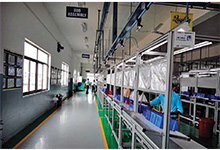The benefits of 5S for lean manufacturing are significant, says Suri. It is suggested that efficiency gains of the order of 10-to-30% can be achieved, and certainly these levels of success have always been achieved through ACT intervention in ACMA member companies. The reasons for these gains in efficiency are manifold and stem from a number of benefits driven by the implementation of 5S. With this concept in place a large number of benefits can be achieved including reduction in search time, creating a safe workplace with conducive work atmosphere, reduction in inventory and breakdowns, improving quality of work and products, improving customer satisfaction and, finally, enhanced employee satisfaction.
 Ravichandran, who has recently received the Fellowship from the Indian National Academy of Engineers, says practising 5S helped about 20 visually challenged people working in the commutator assembly at Lucas-TVS, because it did sort, set, shine and standardise. Due to this, the visually challenged could sustain assembling even safety critical parts with zero defects.
Ravichandran, who has recently received the Fellowship from the Indian National Academy of Engineers, says practising 5S helped about 20 visually challenged people working in the commutator assembly at Lucas-TVS, because it did sort, set, shine and standardise. Due to this, the visually challenged could sustain assembling even safety critical parts with zero defects.
Sarangarajan states, “In order to maintain 5S we have kept the inventory to the much lower level, say 4 hours; this helps us in maintaining the factory well. It has been extended to the vendors as well since it is necessary for them to maintain the inventory as required by us, at the right quantity and at the right time of delivery.” He continued, stating that the company has graduated to the next level of sequence feeding since the last one year. Under this concept there will be only one part available for the operator involved in the assembly. This ensures minimal inventory, warrants lesser space and prevents wrong parts getting into models. This is essential as Hyundai Motor India makes around 1,000 variants in total and at any given point of time there will be at least 200 variants. “You can seldom see same models consecutively in the assembly line,” he says.
The Manufacturing Engineering system developed by the vehicle manufacturer helps network itself with the vendors. At present, parts worth more than 50% in terms of the value of the car are sent through sequence feeding. This helps Hyundai to keep parts away from the plant. Besides, it has standardised the delivery of parts and containers to maintain 5S.
 The benefits according to Sarangarajan are improvement in workers’ morale – it gives confidence to them on the involvement of the management. Secondly, it helps in avoiding quality issues. Besides, it helps in preventing line stoppage for searching of parts. In addition, it keeps everybody on their toes and not under pressure.
The benefits according to Sarangarajan are improvement in workers’ morale – it gives confidence to them on the involvement of the management. Secondly, it helps in avoiding quality issues. Besides, it helps in preventing line stoppage for searching of parts. In addition, it keeps everybody on their toes and not under pressure.
Srivats Ram says 5S enables immediate cash availability as it identifies to the organisations what they do not need. It ushers in cultural change towards better discipline leading to better quality, improvements in production systems, and people empowerment that ultimately lead to manufacturing excellence. Essentially, it gets improvements in performance.
“At ACT we have, over the last 14 years, evolved a roadmap in which we can engage people starting with 5S and building up to further concepts of total employee involvement, kaizens and moving in to advance clusters towards lean manufacturing, SMED etc.,” he says.
At offices even maintaining files in an orderly manner enable everyone to handle at ease. Similarly, it is helpful in the canteen, kitchen and scrap yard. Toyota Kirloskar Motor follows this concept everywhere in the company, including the canteen and kitchen. Following 5S helped the company maintain inventory at very low levels; it has also helped to contain food waste by pictorially depicting the food waste of the previous day.
Medical Centre
The Medical Centre at Lucas-TVS is a classic example of following 5S. The medical records, sorted according to the employee’s number, have colour codes – purple for hypertension and blue for diabetes. The same colour codes are followed by the pharmacy to store the relevant medicines. Besides, the records are arranged with another set of colour codes to avoid monotony to the eye. All this helped in containing the searching time from a few minutes to a few seconds.
The shopfloor of the company is designed to take the ambulance inside and it is possible to drive it in since they practise 5S. Once the employee swipes his or her muster he is alerted on the impending medical checkup. And the system alerts the medical centre for appointment with the doctor, and the pharmacy, to keep medicines ready. The registry, consultation, treatment and pharmacy are lined up – following the single piece flow concept. All these initiatives helped the staff to visit the medical centre for consultation in less than three minutes from more than 20 minutes a few years ago. As a precautionary measure, the centre gives preventive medication for typhoid, hepatitis and other diseases to food handlers at the canteen.













Leave a Reply